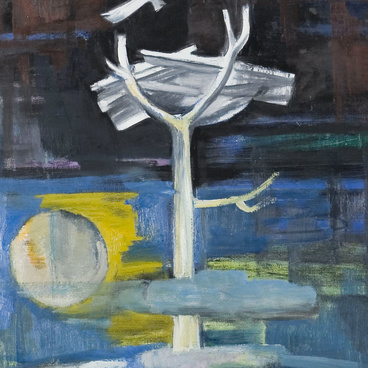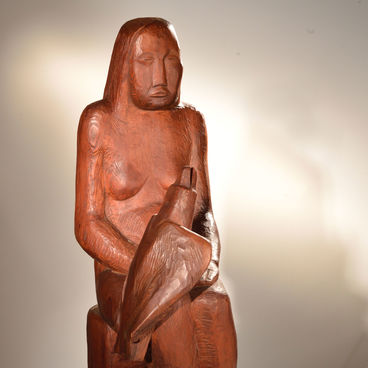Eduard Pakhomov was a Yakut sculptor who had an outstanding artistic intuition and a fine sense of material. He possessed a multifaceted artistic talent and successfully worked with a wide range of materials: stone; wood; metal; and mammoth ivory, which he used to create miniatures.
1 / 2
#1
Eduard Pakhomov
First Poems
#2
#3
‘His works are filled with a personal worldview and there is a vert strong sense of romantic and lyrical feel in them’,
#4
art critic Zinaida Ivanova-Unarova described Pakhomov’s work.
In 1989, Pakhomov created a marble work poetically titled “First Poems”. It represents a female torso with small wings on its back, which resembles antique sculptures.
In many cultures, the image of a woman was considered the ideal of eternal beauty, morality, and purity. For the Sakha people, women have always been associated with the concept of beauty and tenderness. Platon Oyunsky, a Yakut Soviet writer, has noted in one of his works: “Саха - дьахтар таҥаралаах,” which in the Yakut language means “For a Yakut, the woman is a goddess.”
Pakhomov complemented the figure with wings - a symbol of inspiration, spirituality, and freedom. Using this detail, he gave the “First Poems” a romantic feel emphasized by the material selected by the sculptor. It looks as if the marble illuminates the body from the inside and creates a sense of lightness and airiness of the image.
The sculptor’s poetic view of life was new and unusual for the Yakut sculpture of that time. Sculptors usually received commissions to paint ceremonial portraits of war and home-front veterans. Pakhomov was the first to use graceful, gentle, and spiritual images.
In addition to small works, he worked in the genre of monumental sculpture and created many monuments in Yakutsk and beyond. He designed the ‘Semyon Dezhnev and Abakayada’ monument and the ‘Tuymaada Soldier’ memorial in the capital of the Republic, as well as a monument dedicated to the mother of cosmonaut Yuri Gagarin, located in the city of Gagarin, Smolensk Region.
Pakhomov also engaged in community activities. Through efforts of the sculptor, a museum was opened in his homeland: the Vilyuchansk Art Gallery, a branch of the National Museum of Fine Arts of the Republic of Sakha (Yakutia).
In 1989, Pakhomov created a marble work poetically titled “First Poems”. It represents a female torso with small wings on its back, which resembles antique sculptures.
In many cultures, the image of a woman was considered the ideal of eternal beauty, morality, and purity. For the Sakha people, women have always been associated with the concept of beauty and tenderness. Platon Oyunsky, a Yakut Soviet writer, has noted in one of his works: “Саха - дьахтар таҥаралаах,” which in the Yakut language means “For a Yakut, the woman is a goddess.”
Pakhomov complemented the figure with wings - a symbol of inspiration, spirituality, and freedom. Using this detail, he gave the “First Poems” a romantic feel emphasized by the material selected by the sculptor. It looks as if the marble illuminates the body from the inside and creates a sense of lightness and airiness of the image.
The sculptor’s poetic view of life was new and unusual for the Yakut sculpture of that time. Sculptors usually received commissions to paint ceremonial portraits of war and home-front veterans. Pakhomov was the first to use graceful, gentle, and spiritual images.
In addition to small works, he worked in the genre of monumental sculpture and created many monuments in Yakutsk and beyond. He designed the ‘Semyon Dezhnev and Abakayada’ monument and the ‘Tuymaada Soldier’ memorial in the capital of the Republic, as well as a monument dedicated to the mother of cosmonaut Yuri Gagarin, located in the city of Gagarin, Smolensk Region.
Pakhomov also engaged in community activities. Through efforts of the sculptor, a museum was opened in his homeland: the Vilyuchansk Art Gallery, a branch of the National Museum of Fine Arts of the Republic of Sakha (Yakutia).
#5
Republic of Sakha Museum of Art (Yakutia)
read morehide
00:00
00:00
1x
First Poems
Creation period
1989
Dimensions
41x15x10 cm
Technique
marble
Collection
Exhibition
0
Open in app
Share



